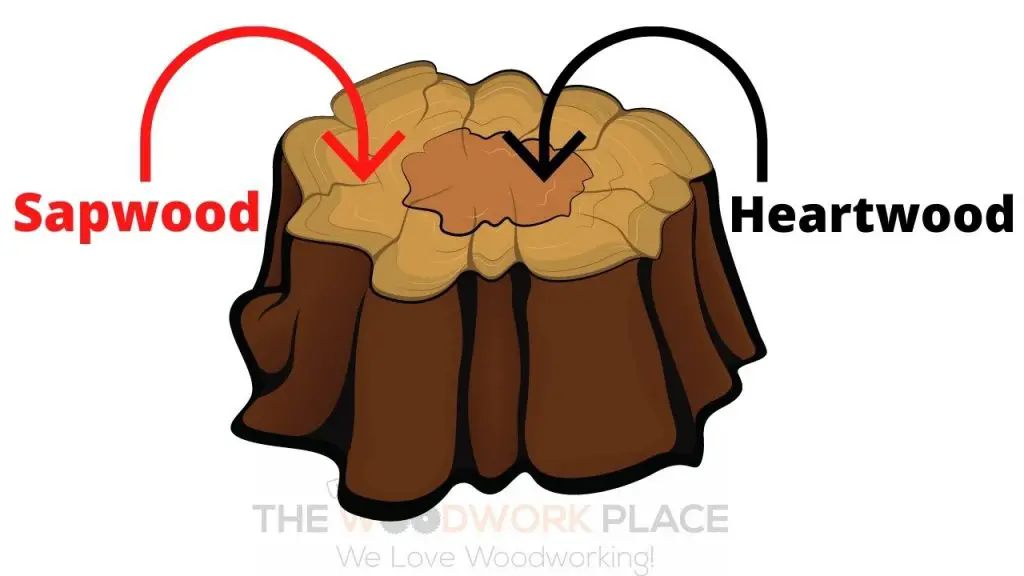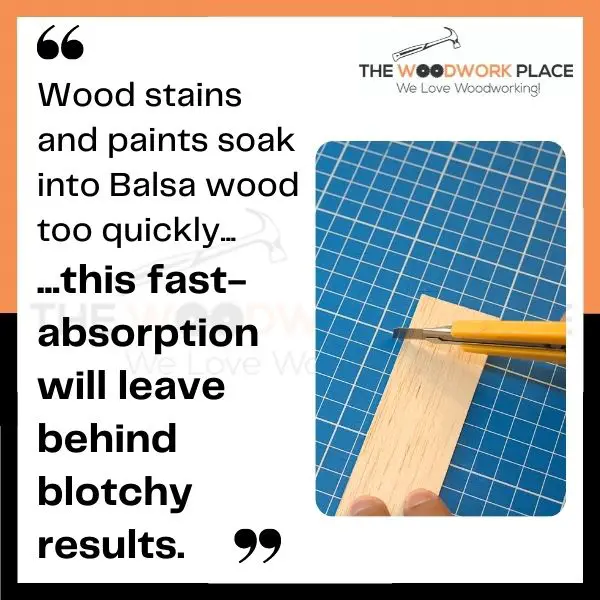One of the most craftily popular woods on the market is Balsa wood. This featherweight hardwood is a great choice timber for whittling beginners and model airplane enthusiasts.
What’s more, Balsa is even lightweight enough to cut with home crafting machines, such as the Cricut Maker.
Related Post: 7 Clever Cricut Maker Wood Projects | TheWoodworkPlace.com
Now, Balsa wood grain actually has some nice texture to it. However, this pale lumber doesn’t have enough contrast for any of that grain to really stand out.
Which is why finishing Balsa wood almost always includes giving it a deep coat of color. But, can Balsa’s coarse-grained surface take on stains and finishes?
Well, in this post, you will learn exactly why Balsa can be tricky to finish…and why stains always turn out blotchy on this hardwood.
You will also learn if you can paint Balsa wood instead…and how to prep the surface of this lumber for a coat of color.
So, let’s get started…

This post may contain affiliate links to products that we receive a commission for (at no additional cost to you). Learn more here.
Why Is Balsa Wood So Hard To Stain?
Officially, Balsa wood is classed as a hardwood. Yet, this lightweight lumber is one of the softest around.
And Balsa wood is so soft due to its low density. That’s because, underneath the surface, this hardwood is very porous.
In fact the sapwood of this tree, (the part used for making those Balsa wood blocks), is more empty air pockets than actual wood fiber.

It’s incredibly low density is one of the main reasons why Balsa wood makes for such great carving wood. However, it is also the reason why this timber is so difficult to stain.
Wood stains work by sinking into wood, coating wood fibers with a pigmented varnish. These penetrating types of stain don’t leave much (if any) build up on the surface. So, they need to soak evenly into lumber, if you want uniform color.
Due to Balsa’s porosity, certain sections of it’s surface will soak up stain faster than other parts. And once that wood stain dries, it will leave Balsa wood looking blotchy.
Related Post: 5 Reasons Why You Should Use Paulownia Vs Balsa Wood
Does That Mean You Can’t Use Stain On Balsa Wood?
Not exactly. You can give Balsa a stain coat, but you will need to take an extra step to prevent uneven coverage.
And that step involves coating Balsa wood with a pre-stain wood conditioner, prior to applying wood stain.
What Does Wood Conditioner Do?
Pre-stain wood conditioners will sink down into Balsa wood. And, that conditioner will fill those wood pores, but without sealing them.
So then, when you apply wood stain afterwards, that stain will soak into Balsa wood more slowly.
Basically, using a wood conditioner will slow down the rate of absorption. And with any luck, that will stop stain from drying out into a blotchy mess.
Related Post: Should I Apply Wood Conditioner Before Danish Oil? (Explained) | TheWoodworkPlace.com
If Not With Wood Stain, How Else Do You Color Balsa Wood?
Sometimes even wood conditioner can’t fill enough Balsa wood pores, to make that stain top coat even. Which is why the best way to color Balsa wood is to simply paint it.
Paint doesn’t need to soak into wood to work (like stains do). Instead, paint sits on the surface, ‘wrapping’ Balsa with a solid coat.
But, while paint doesn’t need to sink into wood to work, it is still a liquid. So paint can sink into Balsa just as readily as stain.
In which case, you will also need to prime the surface of Balsa wood in preparation for a coat of paint…by using sanding sealer.

What Is Sanding Sealer?
Sanding sealers are designed to seal wood grain up completely. This clear finish doesn’t just fill wood pores, it closes them permanently.
Once dry, a sanding sealer can be smoothed out (by sanding it, of course). And that smooth sealed surface is perfect for painting.
Plus, since those Balsa wood pores are closed, this hardwood won’t unevenly absorb the paint.
Can I Use Sanding Sealer With Wood Stain Too?
Well, wood stain works by soaking into wood. If it can’t soak into wood, then it cannot change the color of grain. Essentially, stain changes the hue of lumber from the inside out.
If you use sanding sealer, and then apply wood stain onto it, the stain won’t be able to penetrate that grain.
In short, if you want to color Balsa wood with wood stain, then use wood conditioner. However, if you want to cover Balsa with a coat of paint, then you use sanding sealer.
To Sum Up, Here Are The 3 Key Takeaways From This Post…
- 1). Wood stains and paints soak into Balsa wood too quickly. And this fast-absorption will leave behind blotchy results.
- 2). If you want to coat wood stain onto Balsa, then use pre-stain wood conditioner.
- 3). And if you want to cover it with paint, then prep Balsa wood first with a sanding sealer.
